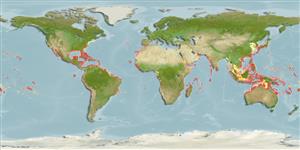Classification / Names
Common names from other countries
Main reference
Size / Weight / Age
Max length : 20.0 cm TL male/unsexed; (Ref. 7251)
Environment
Marine; reef-associated; oceanodromous (Ref. 51243); depth range 0 - 50 m (Ref. 58302), usually 0 - 2 m (Ref. 58302)
Climate / Range
Subtropical, preferred ?; 43°N - 24°S
Distribution
Indian Ocean: tip of South Africa eastward to Indian and Sri Lanka, including the Red Sea, Madagascar, Réunion and Mauritius. Western Pacific: Hokkaido to tropical Australia (as far south as Perth in the west and Sydney in the east), including Taiwan, Philippines, Moluccas, southern Papua New Guinea, Guam, Tonga, New Caledonia and New Zealand; Mariana Islands in Micronesia (Ref. 1602). Occurrence in the eastern Pacific remains problematic. Northwest Atlantic: Canada (Ref. 5951). Western Atlantic: Gulf of Maine to the mouth of the Rio de la Plata, Uruguay. Eastern Atlantic: Azores and off West Africa; record from Vardø, northern Norway (Düben & Koren 1846) is based on a straggler taken northward by the North Atlantic and Norwegian currents.
Countries | FAO areas | Ecosystems | Occurrences | Introductions
Short description
Dorsal
spines
(total): 3;
Dorsal
soft rays
(total): 11-13;
Anal
spines: 0;
Anal
soft rays: 6 - 13. Diagnosis: body short and globose; mouth large with many small, villiform teeth; skin naked, but head, body and fins covered with numerous skin flaps; very long pelvic fins (> 25% SL); unprotected illicium or lure attains less than half of second dorsal-fin spine and 4.5-9.3% of SL (Ref. 57225).
IUCN Red List Status (Ref. 115185)
Threat to humans
Reports of ciguatera poisoning (Ref. 30911)
Human uses
Fisheries: subsistence fisheries; aquarium: commercial
More information
ReferencesAquacultureAquaculture profileStrainsGeneticsAllele frequenciesHeritabilityDiseasesProcessingMass conversion
Tools
Special reports
Download XML
Internet sources
Estimates of some properties based on models
Phylogenetic diversity index
PD50 = 1.0000 many relatives (e.g. carps) 0.5 - 2.0 few relatives (e.g. lungfishes)
Trophic Level
3.9 ±0.63 se; Based on food items.
Resilience
High, minimum population doubling time less than 15 months (Fec assumed to be > 10,000)
Vulnerability
Low vulnerability (10 of 100)
Price category
